Forest Nurseries
The need to establish forest nurseries was a part of the thinking of forestry staff in Victoria from at least as early as the 1860s.
This article is intended to provide an overview of the development and use of forest nurseries managed within the government sector. This section provides a quick summary of the developments, but below you can scroll through extracts from Annual Reports, and some additional comments, that will give you a more detailed picture of what occurred. Apart from many nurseries, local or regional, being a key component of the State's plantation and reforestation programs, it should not be overlooked that nurseries like Wail and Creswick, in particular, were the source for significant plantings for conservation and amenity purposes in all areas of the State. The Victorian landscape, particularly in the north and west of the State has benefited enormously from the seedlings grown and distributed widely from these places. During the 1960s, and into the 1970s, the FCV also oversaw the management of three nurseries associated with prisons which were aligned with significant hardwood reforestation programs.
The first forest nursery was established at Macedon in 1872 and it was not only to become an important nursery but a training ground for forestry staff. (See: From Little Seeds - The History of the Macedon Nursery, 1872-1995)
By 1889/90 there were five nurseries with locations at Macedon, Tintarra (Gunbower), Creswick, Havelock and the You Yangs. They provided seedlings for planting as part of programs on public land, but also (for free in the early days) to the community to help address at least some of the massive land degardation that was occurring from forest clearing for farms and settlement more generally.
See also: Video connected to Havelock Nursery.
Planting of exotic species on public land began at Macedon and then continued into Creswick before expanding widely into other areas of the State. (See: Williams, 2018 on this site)
Until the 1960s nurseries were often established very close to the areas to be developed as softwood plantations, but from the 1960s the focus shifted to major regional nurseries. By 1980/81 there were three major softwood regional nurseries located at Benalla, Rennick and Trentham. These nurseries transferred into the Victorian Plantations Corporation (VPC) in 1993 and moved out of Government hands when VPC was sold to Hancock Natural Resources Group to form Hancock Victorian Plantations (HVP)
The VPC moved to a single new softwood nursery at Gelliondale.
Wail, Creswick Mildura were still operating as extension nurseries into the 1990s, but moved into the private sector in about 1993.
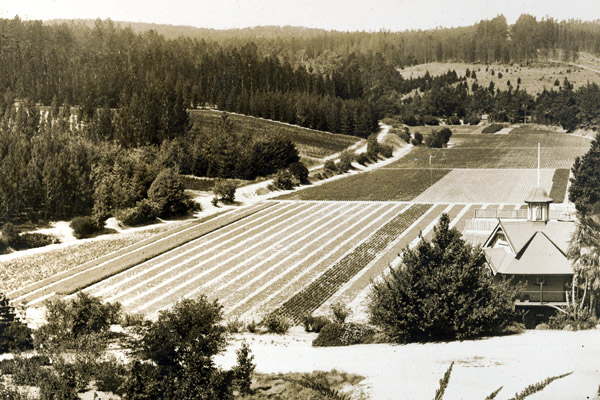
Creswick Nursery
1928
Source: FCRPA
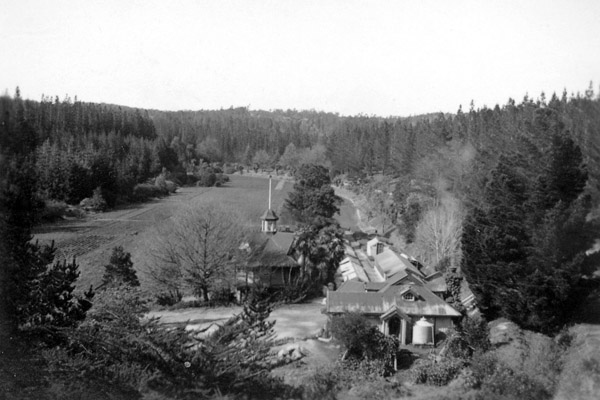
Creswick Nursery
1940
Photo: JD Gillespie, Source: S Gillespie
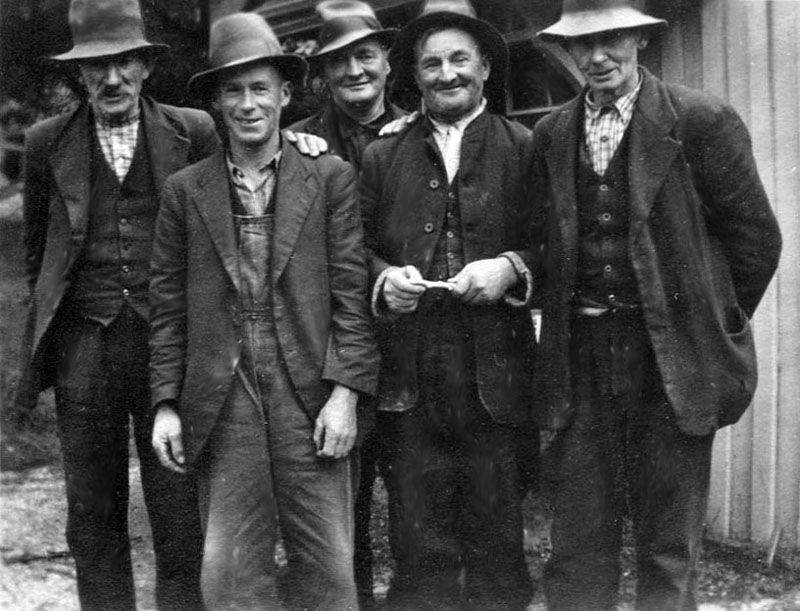
FCV Creswick Nurserymen (l to r) - Mick, Artie, Yank, Dodger (George Herbert Dean), Albert
1940
Photo: JD Gillespie; Source: S Gillespie
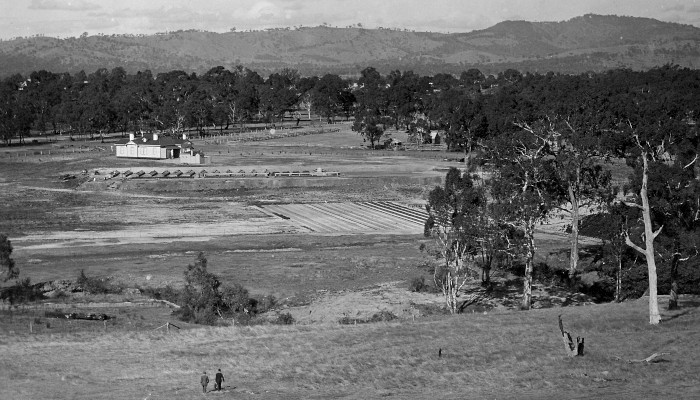
Broadford Nursery
ca. 1925
Source: FCRPA
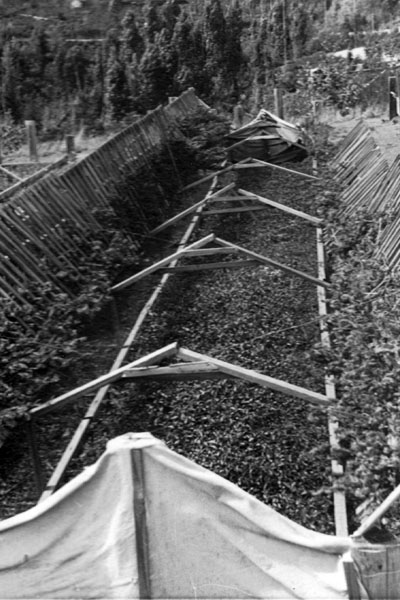
Mountain Ash seedlings being raised at Loch Valley
About 1942
Photo: F Smith, Source: R Smith
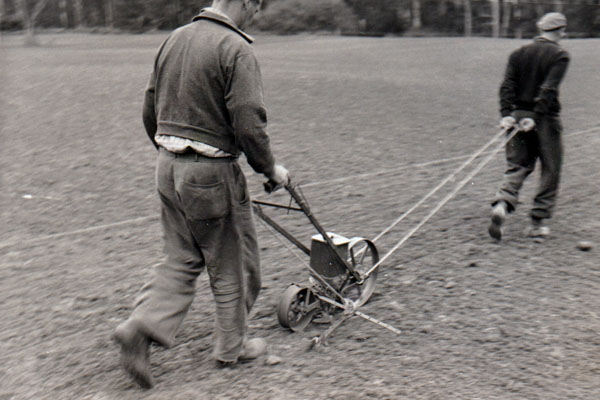
A Mintern Seeder being used at the FCV Dando nursery near Gellibrand.
The nursery was connected with Cooriemungle Prison.
1962
Photo: P Sheehan
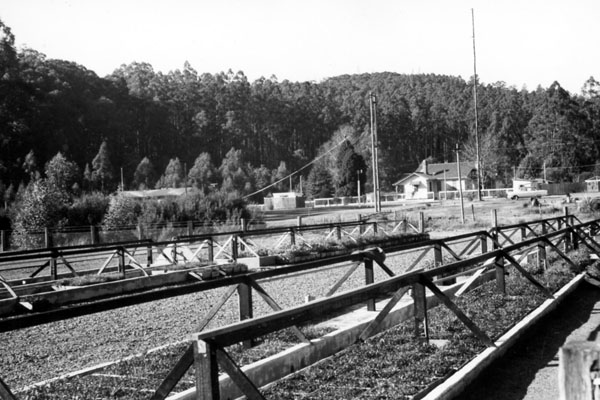
FCV Nursery at Powelltown
1962
Photo: JD Gillespie, Source: S Gillespie
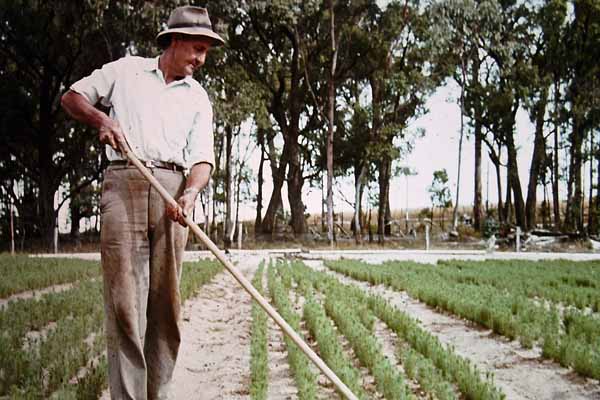
FCV radiata pine nursery at Narbethong - weeding
1967
Photo: N Cox
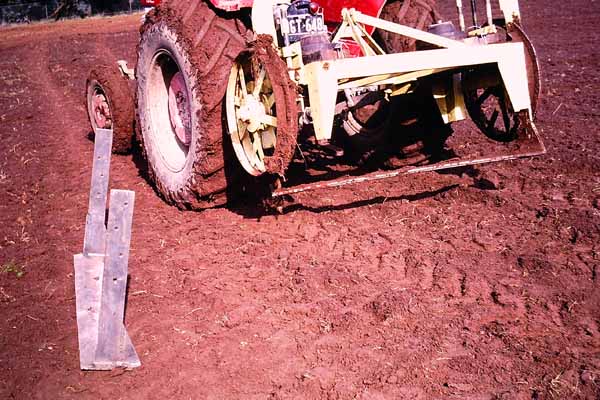
FCV radiata pine nursery at Narbethong - seedling lifter
1967
Photo: N Cox
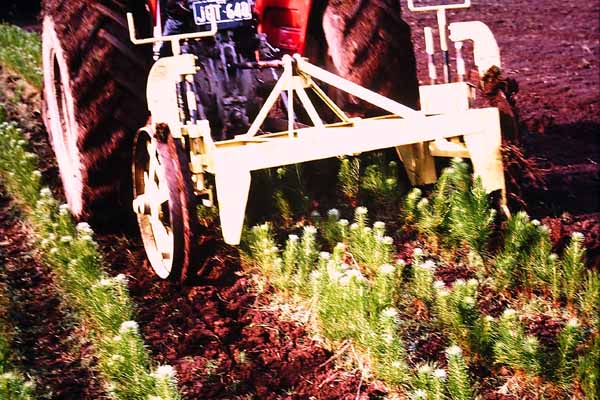
FCV radiata pine nursery at Narbethong - lifting seedlings
1967
Photo: N Cox
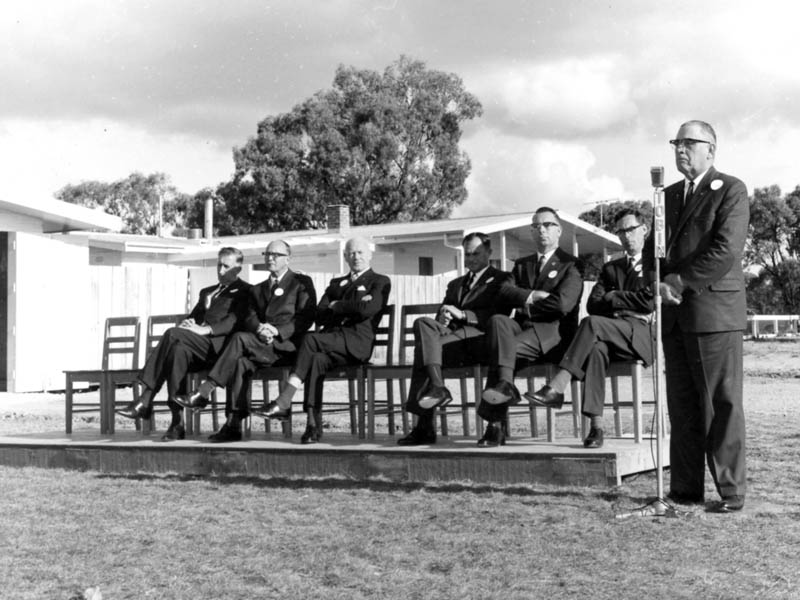
Opening of the new FCV Nursery at Mildura.
Seated (l to r) - FCV Commissioner CW Elsey, FCV Commissioner FR Moulds, FCV Chairman AO Lawrence, ?, MS Whiting MLA (Mildura), FCV DFO I McLaughlin. Standing - AR Mansell MLC (North Western)
13 July 1967
Source: S Gillespie
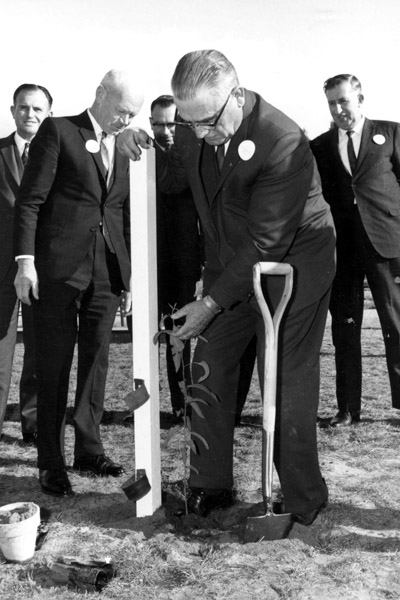
Opening of the new FCV Nursery at Mildura. AR Mansell MLC (North Western) planting a Lemon Scented Gum. Onlookers (l to r) ?, FCV Chairman AO Lawrence, MS Whiting MLA (Mildura), FCV Commissioner CW Elsey
13 July 1967
Source: S Gillespie
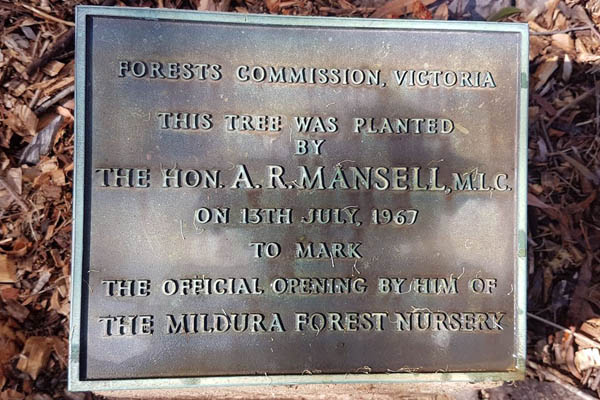
Plaque recording the opening of the new Mildura extension nursery
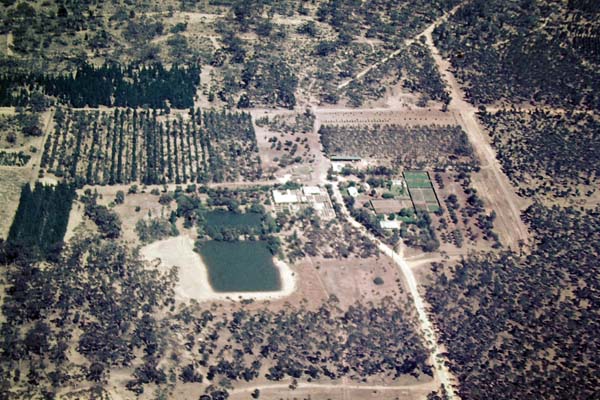
Wail Nursery
1969
Source: G Cleary
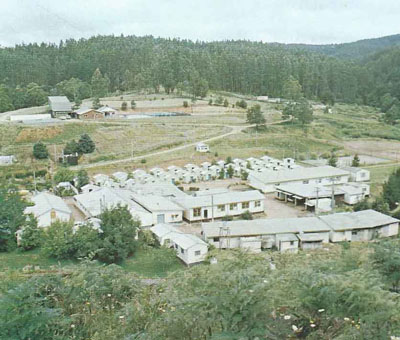
Morwell River Prison Camp with Olsen’s Bridge Nursery in the background
About 1974
Source: WS Noble
Tower Hill
An estimated 250,000 seedlings, the vast majority supplied by FCV nurseries, were used from about 1967 and into the 1980s by the then Fisheries and Wildlife Service to re-establish vegetation on the Tower Hill Wildlife Reserve. (Source: S Cowling)
See Also
Through the Years
Most of the information below comprises quotes from Annual Reports, all of which can be found on this site if you wish to look for more information than is provided here. Some comments are added to the Annual Report extracts where additional information is available.
1889/90
The State nursery at Macedon has, up to season 1888-9, supplied the wants of public institutions.
Finding that one nursery could not keep pace with the constantly increasing demand for trees, a second nursery was established, early in 1888, at Sawpit Gully, near Creswick, under Mr. La Gerche, the local forester.
Shortly after a thoroughly competent nurseryman of European experience, Mr. Hartland, was appointed, and a large number of trees were raised for last year, but the bulk of these trees were too small, and it was considered better to hold them over for another year.
During this winter the trees were shifted to the Australasian paddock, and a new nursery started there. This is now well under way.
At the same time Inspector Blackburne started the nucleus of a nursery at Havelock, and Mr. Young, a nurseryman of experience, was appointed to take charge. This nursery promises well, and a large number of one-year-old trees are planted ready for next season's distribution.
At Gunbower State Forest an important nursery has been started under Mr. Love, superintendent; Mr. Patterson, late foreman at Macedon, taking charge of nursery operations. Here extensive improvements have been carried out under Mr. Love. It is intended to make this nursery the great depot for rearing and distributing the sugar gum under the bamboo system.
In the course of another year or two it is expected that the output of trees from each of these nurseries will reach half-a-million. The following are the nurseries in the order of importance :-
- Macedon State Nursery - Mr. Firth, superintendent; Mr. Parry, foreman.
- Tintarra State Nursery (Gunbower Island) - Mr. Love, superintendent; Mr. Patterson, nurseryman.
- Creswick State Nursery - Mr. J la Gerche, forester; Mr. Hartland, nurseryman.
- Havelock State Nursery - Mr. Blackburne, inspector; Mr. Young, nurseryman.
- You Yangs (a small local nursery) - Mr. Blair, superintendent.
The total number of trees raised during 1889-90, including seedlings (one year and two years old), is at:
- Macedon State Nursery (approximate) - 700,000
- Creswick (one year and seedlings) - 100,000
- Havelock (seedlings) - 64,000
- You Yangs (seedlings) - 20,000
Total number of trees available for this and next season's planting - 884,000.
Comment- While the Havelock and Tintarra nurseries appear to have been in place for a relatively short period, the You Yangs nursery was still in existence in the early 1960s.
- "La Gerche’s workload at Sawpit Gully Plantation had greatly increased due to Perrin’s appointment to Creswick, in August 1889, of William Hartland, ‘a thoroughly competent nurseryman of European experience’, and by the employment of day labourers. Hartland took charge of all nursery operations and plantations under La Gerche’s supervision. A month before, the Forests Branch had purchased the buildings, fencing and paddocks of the New Australasian Gold Mining Company on the volcanic plain in North Creswick. It was Perrin’s original idea to establish a nursery for deciduous trees at the Australasian paddock, while Sawpit nursery raised pines and gums. But, with no water in the Gully in summer, the Sawpit nursery was moved to the Australasian site during the winter of 1890. Planting continued apace, however, at La Gerche’s Sawpit Gully Plantation. By 1899, it covered an area of 300 acres. In 1908, the State nursery returned to Sawpit Gully, downstream from La Gerche’s original site." (Source: A Forester's Log. Angela Taylor, 1998)
1907/08
The output from the State nurseries tbis year has exceeded 200,000 plants. After providing for the forest plantations, with the railway and State school enclosures, a large number of trees have been distributed to country settlers. The latter are chiefly sugar gum and pepper trees for the northern plains, and Monterey pine (P. insignis), Aleppo pine, and Gippsland mahogany for the central and coastal districts.
In view of the coming demand from the plantations, the annual output from the nurseries must be greatly increased. Both of the existing nurseries have defects of soil and situation, which restrict their usefulness as a source of supply, and it is most undesirable to raise forest trees with the aid of fertilisers.
Comment: The Annual Report for 1906 shows images from both the Macedon and Creswick (Australasian paddock site) nurseries.
1909/10
The nursery at Macedon has had a fair output this year of well-rooted plants, both conifers and hardwoods. This is still the main distribution nursery for general purposes. The new nursery for conifers at Creswick has proved a great success, and it has already enabled us to greatly reduce the first cost of the new plantations. The stock of our main conifer nursery this year exceeded 1,500,000 plants; of these some 750,000 will be planted out before the end of the season, while the remainder will be held over, owing to the approach of dry weather, and set out early in autumn.
In Victoria, the standard wage is 7s. per day; yet here, with the advantage of a mild climate and a kindly soil admirably suited, without the aid of fertilizers, to the quick growth of healthy plants, we have been able to raise such conifers as the Corsican, Canary Island, and Monterey pines, and Douglas fir, at a cost slightly under 6s. per 1,000.
1910/11
The total output from the Nurseries at Macedon and Creswick this year exceeded 2,000,000 plants. Provision has been made at Creswick for a much larger output of Eucalypts suitable for the reserves in the Central and Northern Districts. A new tree nursery has been established at Broadford, on the North-eastern railway, about 45 miles from Melbourne. This line affords ready means of transport to the North-eastern, Goulburn Valley, and Northern Districts. The nursery is intended chiefly for the propagation of eucalypts and other hardwoods, and the first year's output is estimated at 750,000 plants.
1913/14
During the year about three and a half million tree-plants were raised at Macedon, Creswick, and Broadford, consisting mainly of eucalypts and conifers, with a smaller number of deciduous trees.
1914/15
Over 3,000,000 plants were raised at the Nurseries, comprising chiefly eucalypts, deciduous trees, and conifers. A large proportion of these were reserved for and planted in State Reserves, whilst large stocks of pine seedlings of species such as Corsican and Canary Island pine, which do not give good results when set out as seedlings, were transplanted for issue as two-year-old plants next year. To the general public, State schools, shire councils, and public parks 47,200 plants were issued. In order to awaken an interest in the planting of fine foliaged trees, many exotic species were issued for parks in country towns, such as the lindens, honey locust, South-African silver tree, and deodar or Himalayan cedar, together with Australian trees such as scarlet flowering gum, the redgum of Western Australia, lemon-scented gum, and silky oak. Victoria has, at the present time, some 4,000 acres under hardwood plantations, 6,000 acres under pine and fir, and 3,000 acres under the best wattles for the production of tanning bark.
1915/16
Over 5,000,000 plants were raised at the nurseries, including eucalypts and conifers, for the plantations, with fine foliaged trees (deciduous as well as evergreen) for general distribution to country districts. Sixty-five thousand plants were issued to State school gardens and to the general public.
1916/17
Careful attention is being paid to the planting of indigenous hardwoods, and especially to Eastern Australian species, such as grey ironbark, red mahogany, tallowwood, New South Wales spotted gum, woollybutt, turpentine, and blackbutt. These, together with Victorian ironbark and sugargum, have been planted during the year at Dimboola, Dargile, near Heathcote, and at Korumburra.
1917/18
The plants issued as a free grant to country settlers, to State schools, and to public bodies are set forth in the return below. (Not included here.) In addition to the ordinary classes to whom grants were made in previous years, a considerable demand arose during the planting season from Committees in charge of memorial avenues for soldiers who had lost their lives in the war, and to meet this a quantity of fine-foliaged trees such as scarlet oak, pin oak, Portugal oak, cedars, elm, and Oriental plane were issued.
1919/1920
The total issues of tree plants from the three State nurseries during the period amounted to 876,107. Of these, 811,922 were used for departmental purposes, 25,720 were issued to the State schools, and 38,465 were disposed of to various public bodies or to private individuals. In addition, some 93,000 trees were raised on individual plantations to meet their own requirements. The latter is undoubtedly the more satisfactory plan wherever the size of the area to be planted justifies it, as it obviates to a large extent the losses and delay entailed by long train journeys from the central nursery. This method promises also to be more economical, and as the extension of it at present contemplated takes place, it will most probably be possible to close down at least one of the three larger nurseries now maintained.
Comment: The "three State nurseries" were presumably, Macedon, Creswick and Broadford. Broadford was the nursery that was closed by 1930/31.
1920/21
The total number of trees planted during the season was 1,336,250, of which 1,011,800 were obtained from the main nurseries and 324,450 were raised in local nurseries on the plantations themselves. Of this total, 1,267,800 were conifers (softwoods), and 68,450 were hardwoods. The Pinus insignis, with a total of 1,162,260, was the chief conifer employed, followed by Pinus ponderosa 32,250, Pseudotsuga Douglasii (Oregon) 32,125, Pinus laricio 20,900, and Pinus maritima 11,000. It is proposed in future years to lessen the preponderance of Pinus insignis, and wherever possible to employ a larger proportion of species, such as Pinus ponderosa, Pinus laricio, and Pseudotsuga Douglasii, which produce a higher grade of timber. At the same time the Pinus insignis, in view of its great adaptability, its quick growth,and the strong demand for its timber for case making and similar purposes, will continue to be extensively employed.
1925/26
Distribution of Trees to the General Public. This department of the Commission's operations is still actively carried on. As a means of helping the settler to provide shelter belts, breaks and beauty spots on his holdings, trees raised in the State Nurseries are distributed at a cheap rate. About 50,000 trees of various species were distributed in the past season. It is the desire of the Commission that as settlement increases there will be a growing demand from the public for such trees suitable not only for the protection of homestead and stock, but for the beautification and improvement of the conditions under which the settler and his family live.
See also:
FCV Mildura Nursery 1926
Creswick Nursery 1925
1929/30
A new nursery area is at present in course of preparation at Stanley, near Beechworth. It is probable that this nursery, being particularly favoured both as regards climatic and soil conditions, will supply much of the higher grade coniferous stock required for the Bright and Ovens Plantation areas as well as raising stock for the prospective extensive plantation scheme locally.
1931/32
The progress of decentralization of nurseries is reflected in the extent to which local nurseries are now providing planting stock for local requirements. Only eight years ago raising of plantation stock was carried out wholly at Broadford (since closed), Creswick, and Macedon Nurseries, while last season the various local nurseries provided 2,692,047 transplants, representing 82 percent of the total planting stock for the year.
1933/34
The stage has now been reached when individual plantations are equipped with nursery facilities capable of providing practically all stock requirements direct from seed or at least from the one-year-old seedling stage. With an accurate knowledge of requirements for a few years ahead as laid down in Working Plans, temporary nurseries are prepared and stocked in advance with grades of planting stock calculated to be of suitable age and size at specific periods. These nurseries, as distinct from local base nurseries, usually function only for three or four years, during which time planting is being carried on within a convenient radius. As planting extends, a further advance nursery is then established.
1938/39
Despite unfavourable seasonal conditions during and subsequent to sowing, an initially satisfactory germination of seed was, with one exception, well maintained up to the advent of the hot period early in January when, at Narbethong and Toorongo nurseries, the as yet tender seedlings succumbed to the intense heat from nearby fires. Stocks of Oregon which had been lined out only a few months previously at Narbethong were likewise unable to withstand the blast, whilst at Toorongo the whole of the nursery stock perished. Losses thus sustained have to an extent curtailed current planting and lining out operations, and will be reflected even more prominently during the 1940 season.
Comment: It has been assumed that the "Toorongo" nursery is the nursery which existed at Loch Valley and was initially a softwood nursery servicing the needs of the developing Loch Valley plantation. After 1939 this nursery also produced tubed Eucalyptus regnans seedlings for planting in some areas burnt by the 1939 fires, and also for the developing reforestation program in the Strzelecki's.
1939/40
A departure from the normal method of raising transplant stock from seed has recently been instituted on a limited scale at Bright. The method adopted - vegetative cultivation of shoots from selected young trees - has been tried out elsewhere, and is designed to prove whether or not the resultant stock will develop characteristics similar to those of the parent tree.
1940/41
The raising of Pinus radiata by vegetative culture of cuttings, which was last year instituted on an experimental scale at Bright, met with a certain measure of success, and provided much interesting although not necessarily conclusive data with respect to percentage "strike" as between noded, straight, and cut and split types of cuttings respectively. Correlation of further data relative to reaction of shoots of different ages and from variable parent stock is at present in progress. In some instances, development has been such as to permit of planting out this season, when further behaviour of the stock will be noted.
1942/43
The Commission intends to undertake extensive planting of softwoods as part of its forestry reconstruction scheme in post-war years. In order that stock may be available to enable at least a part of the actual planting programme to be implemented in the immediate post-war period, it is necessary that nursery stock be prepared beforehand so that suitable transplants may be ready for planting out at any time. For this reason, heavy sowings, particularly of Monterey Pine, were carried out in the past two seasons, although it has been found impossible because of labour shortage to handle the very large quantities of seedlings which resulted. The maximum lining-out programme which could be undertaken with the staff available was completed, and as much as possible of the transplant stock used for essential renewals, most of the balance being disposed of to the public. This policy will be continued even if it involves sacrificing some, if not all, the seedlings and transplants raised.
1944/45
Sowing of seed was effected to the extent of supply available. Upwards of 2,000,000 seedlings of excellent type resulted from the 1944 sowings, and in view of the now more favorable war position and of the necessity for readiness to embark rapidly on planting schemes now in course of preparation, it is most desirable that labour be made available for the lining-out of this seedling stock. An appreciable quantity of transplant stock ready for direct planting is this season being made available for use in connexion with the "Save the Forests" Campaign and for sales to the public.
1946
Wail Nursery (an extension nursery) established.
1946/47
Establishment of a nursery capable of raising seedling stock for an annual programme of up to 1,000 acres, with provision also for the growing of two-year-old stock for seasonal renewal requirements is in hand.
Comment: Is this the Rennick Nursery?
1948/49
Small scale experimental planting of assorted dry climate species was carried out in the vicinity of Wail in the Dimboola district.
1949/50
The Commission's nursery at Wail in the Wimmera has specialized in the propagation of species suitable for planting in the drier areas of the State. A wide range of trees and shrubs indigenous to the arid belt throughout southern Australia has been raised, and field tests on an experimental scale have been established to determine the suitability of the various species for practical use.
1950/51
An extensive range of selected species raised at the Wail nursery met with ready sale, while choice of suitable types of trees and shrubs by intending customers is greatly aided by the opportunity now afforded to inspect the experimental plot, in the vicinity of the nursery.
1958/59
A nursery is being established to provide plants for the Delatite plantation.
1960/61
Forestry Prison Camp. The Government has established a forestry prison camp at Olsen's Bridge near Boolarra under the control of the Department of Social Welfare. It is planned to use prison labour under the technical supervision of the Commission's staff for reforesting abandoned farmlands and thus provide an aspect of work and environment which should assist in prisoner rehabilitation.
1961/62
Forestry Prison Camp. Under the technical supervision of the Commission's staff, prison labour at Olsen's Bridge camp south of Boolarra in Mirboo forest district, assisted in the propagation of 600,000 eucalypts, the planting of 132 acres of hardwoods and the clearing of 350 acres for future planting. Preliminary investigations are in hand for the establishment of a second camp.
1962/63
Forestry Prison Camps. The Morwell River Prison at Olsen's Bridge attained its full complement of men during the year and provided labor for the clearing and planting of abandoned farm land in the South Gippsland hills. Over 500,000 trees were propagated at the nursery by prisoners. Planning is proceeding for establishment of a second forestry prison near Won Wron.
1963/64
Construction of a second camp at Won Wron has commenced.
1964/65
Extension Services. Plants sold to the public and to government and semi-government departments from Commission nurseries were :
- Pinus radiata - 238,820
- Other softwoods - 26,035
- Eucalypts - 140,292
- Acacias - 31,075
- Other species - 100,597
- Total - 536,819
A total of 109,934 trees were supplied free to 228 State school endowment plantations.
Work has commenced on a new nursery site at Mildura to replace the existing Merbein nursery.
1966/67
The use of transplants of P. radiata continues to decrease. Current practice is to use one year old seedlings, except in areas where rapid scrub growth on cleared areas makes establishment difficult.
1967/68
The development of regional nurseries at Rennick, Trentham, Benalla, Tallangatta and Marysville continued. The Marysville nursery will be devoted to the production of species other than radiata pine. A new extension nursery at Mildura is opened on 13 July 1967.
Comment: Marysville is synonymous with "Narbethong" in 1968/69. This 1968 Tree Price List shows the species being produced at the Creswick and Macedon nurseries.
1968/69
Regional nurseries at Trentham, Rennick, Benalla, Tallangatta and Narbethong are now almost fully developed. The Narbethong nursery is being developed as an "other species " nursery and will raise all the softwood species required other than P. radiata, and apart from P. pinaster (Maritime pine) which will continue to be raised at Rennick. The trend continues towards use of one-year-old stock. Only 6.5 per cent. of the total P. radiata stock was held for two years in the nursery before planting out in the field. The Tree Price List issued in 1968 for the Macedon and Creswick Nurseries can be found at this link. Note the huge range of species that were available.
Comment: The "Tallangatta" nursery was the nursery at Shelley Camp, Koetong which operated on two different sites near the camp. It was established in the same year (1961) that planting of the Koetong Plantation commenced.
1969/70
Development of regional nurseries at Rennick, Trentham, Benalla, Tallangatta and Marysville continued. Improved results were achieved in grade and uniformity of stock. Seed stratification has become fully operational and extensions were made to enable greater quantities of seed to be treated simultaneously. Mechanization of the nurseries was further developed. The packaging of nursery stock for transport was under constant review and a number of types of boxes were tested. The development of regional nurseries and the phasing out of local nurseries resulted in a significant increase in the number of plants raised per pound of seed.
1970/71
The regional nurseries are now operating efficiently. To further improve techniques discussions have been held with manufacturers on a proposal to construct a mechanical seedling lifter. Packaging of P. radiata seedlings is now standardised using polyetheylene-lined fibre board boxes and trees are weighed instead of counted to determine the number despatched. This has significantly reduced packing costs with no significant loss in control of numbers.
1972/73
Improvements carried out in the nurseries over recent years have resulted in more efficient production of plants. Benalla and Trentham nurseries can now each despatch at the rate of one-half million plants a week.
1974/75
The total output of the eight nurseries raising hardwood stocks for Commission plantings increased by five per cent. The greatest quantity was grown at the Morwell River prison nursery in the Mirboo District. The newly established Won Wron prison nursery at Yarram and the Cooriemungle prison nursery at Gellibrand made significant contributions. Further development works were undertaken at Won Wron and Cooriemungle and improved facilities provided at Morwell River.
1975/76
Benalla Regional Nursery produces more than five million Pinus radiata seedlings annually for planting in Commission projects, farm forests and by industry and private landowners. The regional nurseries at Tallangatta (Koetong), Benalla, Trentham and Rennick produce softwood plants for the Commission's planting program, Farm Forestry Agreement holders and other private landowners. The extension nurseries at Mildura, Wail, Creswick and Macedon grew a variety of native and exotic plants, mainly for sale to the public and for other Government Departments.
1977/78
The nursery at Cooriemungle prison farm, which produced seedlings in previous years, has now been closed.
1980/81
Comment: By 1980/81 there are just three major pine nurseries - Rennick, Benalla and Trentham
1981/82 to 1983/84
Some 2.34 million conifer seedlings were raised in regional nurseries and sold to private companies and landowners.
Sales of other exotic and native trees over the past three years were:
1981/82 - 790688
1982/83 - 894635
1983/84 - 940366
The public purchased some 26.5 kilograms of seed, principally radiata pine. The Commission provided many schools within Victoria with a total of 20,280 pine seedlings and 5,740 hardwood seedlings for use in plantations and arboreta. Forty thousand native trees and shrubs, raised at Won Wron and Wail nurseries, were provided free for distribution to the public during the "Keep Australia Beautiful" Week. Stock grown in Commission nurseries was supplied, as in the past, for presentation by the Garden State Committee.
